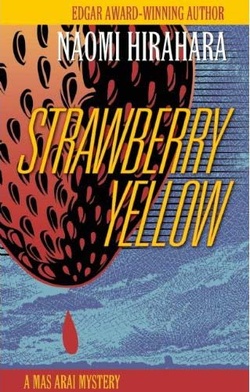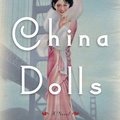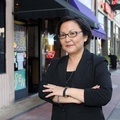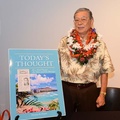Fans of Naomi Hirahara should prepare to turn off their cell phones and curl up in their favorite reading chair. Their most beloved detective, Mas Arai, will put his investigative skills to work once again in Hirahara’s newest novel, Strawberry Yellow.
Upon learning of his second cousin Shug’s sudden death, Mas returns to Watsonville, a small town in Northern California. Mas’ plan to make a brief appearance in his hometown to attend the funeral is quickly thwarted when Minnie, Shug’s widow, shares her suspicions that Shug was murdered and pleads with Mas to extend his stay. Unable to refuse, the socially awkward protagonist must confront his past in working to solve the mystery of his friend’s death.
For Naomi Hirahara, the writing of Strawberry Yellow became a journey into her past as well because of her own personal ties to the setting of the novel. In a recent interview, Hirahara reminisced about her memories of Watsonville. “My late father was born in Watsonville; actually I believe that his own grandfather had lived and died in the town in the early 1930s. Actually, my great-grandfather’s untimely death due to farm-related accident led my grandparents, father, uncles, and aunt to relocate to Hiroshima. After World War II, my father, like Mas, returned to Watsonville and lived in his relatives’ amazing Victorian home. This was the home we usually visited every summer for a few days. It was amazing for a city girl like me to run around greenhouses and fields, to eat frozen strawberries from a huge freezer in a shed. I loved being part of a large extended family for at least a few days.”
The competitive business of strawberry farming, the foundation of Watsonville’s economy, also becomes an integral part of the plotline of Strawberry Yellow. The scientific details are fascinating and will bring readers to wonder about the source of Hirahara’s extensive knowledge. She explained, “When I did research for the Manabi Hirasaki biography, the genetics of strawberry growing fascinated me. Developing patents are crucial for strawberry distributors; the University of California, in fact, is known for their strawberry patents. Agriculture, especially for a labor-intensive crop like strawberries, is very complex and multi-faceted. Sometimes we city folks dismiss farming as merely involving dirt, rain, and sun, but for that beautiful red strawberry to appear on our tables, much technology and public policy had to be invested in its creation.” In addition to being entertained, readers will feel as though they have received an informal agricultural education.
As readers of the series have come to appreciate and expect, Strawberry Yellow is as much about character development as it is about the solving of mysteries. Naomi Hirahara commented on the ways in which Mas Arai has evolved throughout the various books of the series. “In Blood Hina, Mas had to deal with the realities of romantic relationships. His best friend, Haruo, was getting remarried and Mas was getting closer to his love interest, Genessee. In Strawberry Yellow, Mas has to make peace with his past in California. Mas treasures his anonymity, but in Strawberry Yellow the Arai name carries weight and history. He’s not used to that.” Hirahara succeeds in giving her protagonist a heart rather than creating a caricature. As in past novels, Mas struggles with the conflict between his social awkwardness and his conscience to do what is right. However, although certain elements of this book will ring a note of familiarity, author Hirahara allows her detective to evolve in realistic ways. In this installment of the series, Mas Arai functions within a family with all of its modern dysfunctions. The characters are touchingly realistic, flaws and all.
For readers who can never get enough of Mas Arai, the author already has plans for two more books in the series. “The next will take place at Dodger Stadium, where his son-in-law works as a greens-keeper. I’m a huge sports fan (more basketball than baseball actually) and wanted to touch upon the international aspects of baseball and the history of Japanese American baseball leagues, as well as the cult of celebrity. One of my readers, a community college professor, actually informed me that there is actually a Japanese garden, now neglected, in the stadium parking lot. I will definitely work that into the book. The last book will take Mas back to Japan, specifically Hiroshima. I actually spent a month in Japan last year, but two weeks of that was spent in doing relief work in the Tohoku region. I probably need to go back to do further research.”
Like the novels that came before it—Summer of the Big Bachi, Gasa-Gasa Girl, Snakeskin Shamisen, and Blood Hina—Strawberry Yellow is much more than a detective novel. Yes, Hirahara has an amazing gift for weaving together clues and plot twists. However, the heart of the novel resides in its theme. Despite his misgivings about involving himself in the complicated family relationships of the past and present, Mas Arai proves to be a man of courage and integrity by putting his life in danger for the people he loves. As Genessee reminds Mas, “Never underestimate the importance of family.” And, as her fans will attest, never underestimate the writing of Naomi Hirahara!
In addition to her mystery writing and oral history workshops, Naomi Hirahara will be conducting a conversation about Strawberry Yellow at the Japanese American National Museum on Saturday, March 30th.
* * *
BOOKS & CONVERSATIONS
Strawberry Yellow by Naomi Hirahara
Saturday, March 30, 2013 • 2PM
Japanese American National Museum
Los Angeles, California
For more details >>
Strawberry Yellow is available for purchase through the JANM Store >>
© 2013 Leslie Yamaguchi







